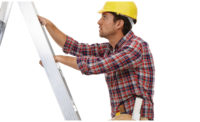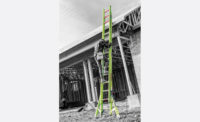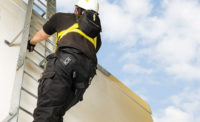Even though ladders have been around for most of recorded history, they haven’t changed much in function and design since their primitive origins.
This simple design is so practical almost everyone uses it; on the other hand, it is so basic it is also easy to misuse and can be dangerous.
Falling is one of the leading causes of accidents and injuries in the workplace, and ladders are involved in a high percentage of these accidents. Misuse or ladder damage cause most ladder accidents, meaning most of these accidents are preventable and should have been identified in the pre-use inspection.
Choose the right ladder
Stepladders are designed to be used in the open (A-frame) position, and you should never stand on the top step or top cap of the ladder. Even if a stepladder is tall enough, never use it to access a roof. If you are climbing onto a roof, use an extension ladder.
- Material – Fiberglass has the advantage of being nonconductive, but if you are not working around electricity, aluminum is a lighter and more durable material. If you are using an aluminum ladder, make sure to check overhead for existing power lines.
- Weight Rating – Chances are, a ladder on a worksite will be used by everyone, so plan for the biggest person on your crew. Calculate the weight rating required by adding the user’s weight, clothing, gear and tools. Type 1A 300 lbs-rated and Type1AA 375 lbs-rated ladders will be a little heavier but will also be more durable.
- Length – When set at the proper 4 to 1 (75.5 degree) angle, your ladder should extend three feet above the roofline, providing the user something to hold onto as they transition on and off the roof. Walkthrough attachments used at the top of your ladder are designed to satisfy that 3-foot requirement. Fifty-five percent of all the ladder-related OSHA citations are because the ladders are not set up properly with 3 feet extending past the roofline.
Inspection
Ladders should be inspected before every use. If there is damage to the ladder that wasn’t there when it was new, don’t climb it. There is no way of knowing what a damaged ladder can hold. If the side rails or rungs are broken, bent, cracked or split, don’t use it. It is important to inspect the feet of the ladder. If the tread on the feet is worn down or missing, replace the feet before you use it.
Proper set-up and use
Surprisingly, a high percentage of ladder injuries are from handling and set up. Ladders are heavy and awkward because of their size. Always use caution when removing a ladder from a ladder rack. Find the balance point and carry the ladder with the front slightly elevated. When setting up, always look up first so you know what is above you. Set the ladder on a flat, dry spot. Stake off and tie off whenever possible. Never set the ladder in front of a door that opens outward unless the door is blocked off. If you must work near a corner or blind spot, make sure the area is properly marked.
Never level the ladder by shimming with bricks or boards. Instead, dig out the high side. Several types of leg levelers are available on the market, so you can adjust to uneven ground. Even better, new ladders on the market are built with adjustable outriggers that provide leveling and extra side-tip stability.
When climbing a ladder, always maintain three points of contact. Never climb a ladder while carrying tools or equipment. Instead, use a rope to raise and lower tools after you have climbed to the desired height.
Belt buckle rule
Always keep the center of your body (belt buckle) between the side rails of the ladder. Never overreach. If you can't safely reach something, climb down, move the ladder and climb again. Always climb facing the ladder; wear proper foot wear, and make sure all spreader bars and latches are fully locked.
Following these guidelines will reduce your risk when working with ladders. Choose the right ladder, inspect it, set it up properly and climb safe!



